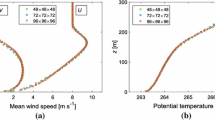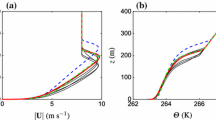A model for the simultaneous transport of heat and water vapor is presented. In an effort to resolve the structure of the entrainment region at the inversion base, models are constructed so as to satisfy realizability as far as possible. Density anomaly and water vapor mixture fraction (specific humidity) are taken as the basic variables. Algebraic expressions for the third moments are derived from first principles, and contain no adjustable constants. Separate equations are carried for the dissipation of each variance, constructed to give rational behavior of all time scale ratios. New forms for relaxation and cross-dissipation terms are constructed in such a way as to guarantee realizability. We describe how realizability was used as a tool to construct these models. We present preliminary results without mean velocity gradients for a dry surface mixed layer leaving the land and starting over water, producing a stable internal humidity boundary layer, but with large fluxes of sensible heat and water vapor (local advection).
Similar content being viewed by others
Bibliography
Choi, K.-S. & Lumley, J. L. 1984. The Return to Isotropy of Homogeneous Turbulence; Experiment and Modeling. Sibley School of Mechanical and Aerospace Engineering Report No. FDA 84–02. Ithaca, NY: Cornell. To be submitted to the Journal of Fluid Mechanics.
Ettestad, D. & Lumley, J. L. 1983. Parameterizing the effect of turbulent transport in swirling flows. I — Theoretical considerations. In Fourth Symposium of Turbulent Shear Flows, eds. L. J. S. Bradbury et al. Karlsruhe: The University.
Janicka, J. & Lumley, J. L. 1981. Second order modeling in non-constant density flows. Sibley School of Mechanical and Aerospace Engineering Report No. FDA 80–01. Ithaca, NY: Cornell.
Lumley, J. L. 1978a. Computational modeling of turbulent flows. In Advances in Applied Mechanics 18, ed. C.-S. Yih, pp. 123–176. New York: Academic Press.
Lumley, J. L. 1978b. Turbulent transport of passive contaminants and particles: fundamentals and advanced methods of numerical modeling. In Pollutant Dispersal, lecture series 1978–7. Rhode-St.-Genese, Belgium: Von Karman Institite for Fluid Dynamics.
Lumley, J. L. 1980a. Some fundamental aspects of turbulence with implications in geophysical flows. In Marine Turbulence, ed. J. C. J. Nihoul, pp. 175–192. Amsterdam, Netherlands: Elsevier.
Lumley, J. L., Zeman, O. & Siess, J. 1978. The influence of buoyancy on turbulent transport. J. Fluid Mech. 84: 581–597.
Newman, G. R., Launder, B. E. & Lumley, J. L. 1981. Modeling the behavior of homogeneous scalar turbulence. J. Fluid Mech. 111: 217–232.
Newman, G. R., Lumley, J. L. & Warhaft, Z. 1977. The decay of temperature fluctuations in isotropic turbulence. In 6th Australasian Hydraulics and Fluid Mechanics Conference, pp. 5–40. Australia: The Institution of Engineers.
Rao, K. S., Wyngaard, J. C. & Coté, O. R. 1974. Local advection of momentum, heat and moisture in micrometeorology. Boundary Layer Meteorology 7: 331–348.
Shin, T.-H. 1984. Second Order Modeling of Scalar Turbulent Flow. Ph. D. Thesis. Ithaca, NY: Cornell.
Shih, T.-H. & Lumley, J. L. 1981. Influence of time scale ratio on scalar flux relaxation: modeling Sirivat & Warhaft's homogeneous passive scalar fluctuations. Sibley School of Mechanical and Aerospace Engineering Report No. FDA-81–06. Ithaca NY: Cornell.
Sirivat, A. & Warhaft, Z. 1980. Preliminary measurements of Helium and temperature fluctuations in grid turbulence. Paper BA5 read at the American Physical Society, Division of Fluid Dynamics meeting at Cornell University, November 23–25, 1980. (Abstract p. 1074, Bulletin of the APS vol. 25, No. 9).
Sirivat, A. & Warhaft, Z. 1981a. The mixing of passive Helium and temperature fluctuations in grid turbulence. Submitted to J. Fluid Mech.
Sirivat, A. & Warhaft, Z. 1981b. Experiments on the evolution of temperature variance and flux in the presence of a linear thermal gradient in grid turbulence. In Preparation.
Taulbee, D. B. & Lumley, J. L. 1981. Implications regarding large eddy structures from attempts to model turbulent transport. In Applications of Fluid Mechanics and Heat Transfer to Energy and Environmental Problems, eds. D. D. Papailiou and D. K. Papailiou. Berlin/Heidelberg/New York: Springer. In Press.
Tennekes, H. & Lumley, J. L. 1972. A First Course in Turbulence. Cambridge, MA: MIT Press.
Warhaft, Z. 1980a. An experimental study of the effect of uniform strain on thermal fluctuations in grid generated turbulence. J. Fluid Mech. 99: 545–573.
Warhaft, Z. 1980b. The use of dual heat injection to infer scalar covariance decay in grid turbulence. J. Fluid Mech. In Press.
Warhaft, Z. & Lumley, J. L. 1978a. An experimental study of the decay of temperature fluctuations in grid-generated turbulence. J. Fluid Mech. 88: 659–684.
Warhaft, Z. & Lumley, J. L. 1978b. The decay of temperature fluctuations and heat flux in grid generated turbulence. In Lecture Notes in Physics, Vol. 76, Structure and Mechanisms of Turbulence II, ed H. Fiedler, pp. 113–123. Berlin/.Heidelberg/New York: Springer-Verlag.
Zeman, O. & Lumley, J. L. 1976a. Turbulence and diffusion modeling in buoyancy driven mixed layers. In Proceedings of Third Symposium on Atmospheric Turbulence, Diffusion and Air Quality, Raleigh, NC, pp. 38–45. Boston, MA: American Meteorological Society.
Zeman, O. & Lumley, J. L. 1976b. Modeling buoyancy-driven mixed layers. J. Atmos. Sci. 33, 10: 1974–88.
Zeman, O. & Lumley, J. L. 1976c. A Second-order model for buoyancydriven mixed layers. In Proceedings, 9th ICHMT International Seminar “Turbulent Buoyant Convection”, Dubrovnik, pp. 65–76. Washington, DC: Hemisphere Publishing.
Zeman, O. & Lumley, J. L. 1979. Buoyancy effects in entraining turbulent boundary layers: a second-order closure study. In Turbulent Shear Flows I, eds. F. Durst, B. E. Launder, F. W. Schmidt and J. H. Whitelaw, pp. 295–302. Berlin/Heidelberg: Springer-Verlag.
Zeman, O. & Lumley, J. L. 1982. Modeling salt-fingering structures. J. Marine Research 40, 2: 315–330.
Zeman, O. & Lumley, J. L. 1983. Progress in the modeling of multi-layer salt-fingering structures. Mathematical Modeling 4: 73–85.
Author information
Authors and Affiliations
Rights and permissions
About this article
Cite this article
Lumley, J.L., Mansfield, P. Second order modeling of turbulent transport in the surface mixed layer. Boundary-Layer Meteorol 30, 109–142 (1984). https://doi.org/10.1007/BF00121951
Issue Date:
DOI: https://doi.org/10.1007/BF00121951




